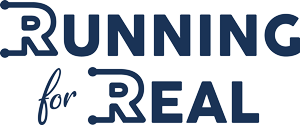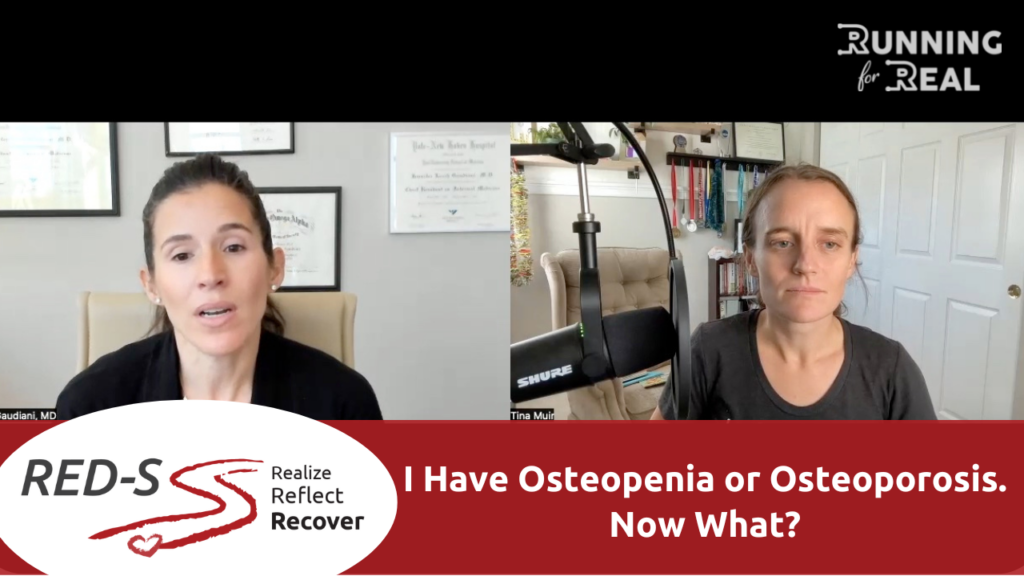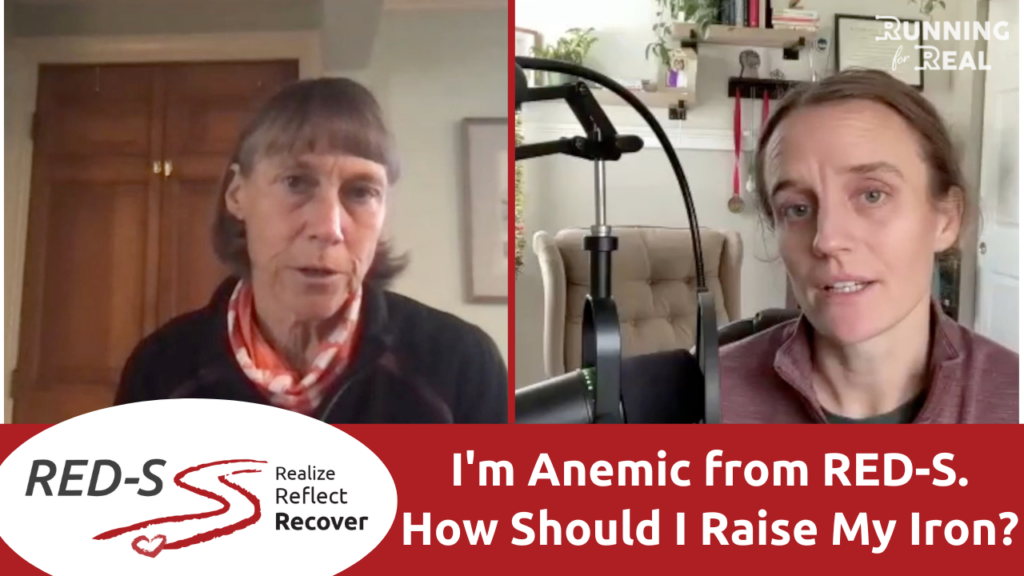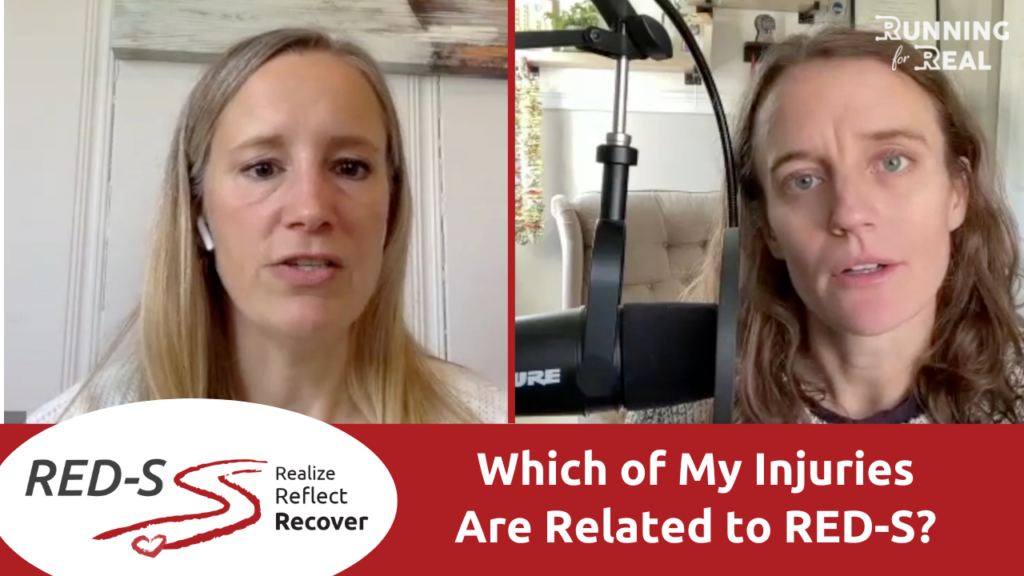For many years, doctors have prescribed birth control pills to cause menstruation. But as Dr. Jennifer Guadiani explains, that doesn’t solve the core issue of hypothalamic amenorrhea, which is that the brain isn’t producing enough estrogen. The deficiency of estrogen is caused by inadequate fueling, so until the underlying issue of RED-S / REDs (Relative Energy Deficiency in Sport) is addressed, the “fix” is basically cosmetic.
It may also give a false sense that since you’re having a period, everything is fine. The reality is that your bone health is still suffering, because oral birth control pills don’t act upon bone. Dr. Gaudiani clarifies the treatment that you can use to protect your bones and uterus while you recover from RED-S / REDs, but emphasizes that it should only be considered a temporary measure and not a substitute for regaining your natural period.
Read the transcript
[Tina] My doctor said I should go on birth control to increase my estradiol. Should I?
[Jen] Nope. The short answer is, “No.” One can go on birth control pills to prevent pregnancy. That’s a very reasonable reason to go on birth control pills, but we know without any question now, that birth control pills do not solve the core problem of hypothalamic amenorrhea, where the brain isn’t producing enough estrogen as a result of inadequate fueling.
So, people used to do that for many, many years, and unfortunately, the overly simplistic thinking was, “Oh, she doesn’t have a period. Let’s put her on a pill; she’ll get a period; everything’s fixed.” So many people listening to this will have been treated that way. Unfortunately, as science awareness grows, we learn things that were wrong, and that was wrong. The reason it’s wrong is this: as long as one has a uterus and a vagina, it’s typically birth control pills will give you a period. Now very low dose ones may specifically not, and that’s a different situation, but if you’re on a high enough dose pill, you will build up a lining and you will release it, but that’s not having one’s period in the natural sense of the canary in the coal mine, because somebody who is under nourishing and on a high enough dose of birth control pill will have a period, but their bones will continue to suffer.
Interestingly, the way that oral birth control pills are metabolized specifically by the liver, they don’t have a chance to act upon the bones. So if you want to avoid pregnancy and that’s the only way to do it, by all means, please go on the birth control pill. However, if you want to treat with estrogen the general state of having hypothalamic amenorrhea, we need to use patch estrogen. Now patch estrogen is something you put on your skin. It’s twice a week. It gives you the same amount of estrogen you would be producing were you not to have undernourishment, so it’s not giving you excess estrogen, but it’s a very important bridge to your doing the natural thing, which is resting and nourishing better.
If it’s going to take you a minute, “a minute,” to get to that safe, natural place, by all means, use transdermal patch estrogen. In addition to the estrogen you also have to protect your uterus, because you don’t just want to give it the message, “Hey stimulate, stimulate, stimulate.” You need to actually have something oppose that, and that’s called progesterone.
So I have no financial investment in anything I’m talking about here. They need to take a bioidentical progesterone typically, 10 days a month. I usually say the first through the tenth of each month. And they will begin to have a vaginal bleed, most people around day seven, and that will continue for a few days. Again, that is not, you have fixed your period. It’s still purely chemical, but the transdermal estrogen will protect your bones. And studies have also shown that in athletes, it improves cognition and memory, so great. You know, if we’re going to take a while to get to that place of natural, nourished, well, period is happy, please protect your bones over the course of those six to 12 months until you can get there yourself.
In teenagers, we don’t give estrogen until they’ve achieved their full growth, or you may close their growth plates and stop linear growth. But if a young woman who’s 15 plus, is fully grown, and it’s going to take more than three or four months to get into a well place, and this may have more to do with anorexia nervosa than it does with RED-S but maybe not, they too should take transdermal estrogen, as well as monthly progesterone. The only folks who don’t need the monthly progesterone to protect their uterus are the ones who have a progesterone-lined IUD in their uterus for birth control. That works fine to protect the uterus and it’s a really nice twofer, because patch estrogen is not birth control. So if someone is sexually active and does not wish to get pregnant, and needs patch estrogen to bridge the gap, they also need to use some sort of backup birth control, and oftentimes a progesterone lined IUD is a great way to do that.
[Tina] Thank you. Two follow-up questions there. One, who would the person be to speak to about the transdermal patch and the progesterone, if the general practitioner, or whoever they went to, was the person who suggested go on birth control?
[Jen] Sometimes general practitioners are open to redirection by patients. And sometimes they’re really snarly and mean about it. I hope that those listening to it have really nice GPs, who when presented with good evidence, whether it’s these videos or a blog that says, “Actually, here’s the science,” they say, “Oh gosh, thanks for teaching me that. I’d be happy to prescribe you estrogen patches.” If they’re not that sort of person though, asking for a referral to an endocrinologist or to a gynecologist is a very reasonable next step.
[Tina] Okay, thank you. And one follow-up for having this transdermal patch and the progesterone. What would you say to someone whose mind maybe then thinks, “Okay, well maybe I’ll just do that, and that takes care of everything. I don’t need to work on the RED-S”?
[Jen] The reality is that the patch estrogen is only going to take care of one arm of the bone density equation. It will help reduce bone resorption, but if you’ve still got RED-S, you’re not making bone, so you’re still really at high risk of bone density loss and complications. But more broadly speaking, if you’re stuck in a mindset of, “That’s all I need to do,” then we need again to think, “Is this RED-S or is this anorexia nervosa?” Because at the point at which you know something’s wrong with your body, you know that nourishment and greater rest could heal it and you’re tempted to continue to push your body in an unhealthy way, we may have ended up more in a formal eating disorder there that has to be addressed as such, rather than that sort of like, “Whoops, accidentally I’ve underfueled myself.”
[Tina] Okay, thank you.
check it out
Recovering from RED-S is hard. It’s even harder if you’re working through it alone. Even if you have professional support, they’re not available 24-7, and that can lead to going down search engine rabbit holes that have the potential to derail everything.
Our online resource, RED-S: Realize. Reflect. Recover, will answer all those questions swimming around in your head about recovery. It will give you the opportunity to connect with the experts you’ve come to know here, and to surround yourself with a community of others who are going through it too. THANK YOU! to Athletic Greens and Tracksmith for supporting this YouTube series and RED-S: Realize. Reflect. Recover.
Go to athleticgreens.com/reds to get five free travel packs of AG1 and a free one year’s supply of vitamin D3+K2 with your subscription!
When you go to https://tracksmith.com/tina and use the code TINA15 at checkout, you’ll get free shipping and Tracksmith will donate 5% of your order to Rising Hearts, the Indigenous-led nonprofit founded by Jordan Marie Daniels.
more about Dr G:
Dr. Jennifer Gaudiani, CEDS-S, FAED, is an internist who specializes in eating disorders. She practices from a deeply anti-diet, weight-inclusive perspective and partners with therapists and dietitians around the country to ameliorate medical roadblocks in patients’ recovery journeys. Her book, “Sick Enough: A Guide to the Medical Complications of Eating Disorders,” is for patients, families, and practitioners. You can find Jen at https://gaudianiclinic.com




